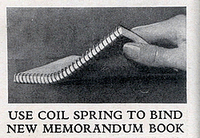 While we tend to take such a mundane item as the legal pad for granted, it is a relatively recent invention. Otherwise, the Declaration of Independence would doubtless be saved on long, yellow pages.
While we tend to take such a mundane item as the legal pad for granted, it is a relatively recent invention. Otherwise, the Declaration of Independence would doubtless be saved on long, yellow pages.LegalAffairs: The Magazine at the Intersection of Law and Life, has a nice history of the legal pad in its May/June 2005 issue. "Old Yeller," by Suzanne Snider, recounts the history of the legal pad. In 1888 a 24 year old worker in a paper mill in Holyoke, Massachusetts, had the idea of binding paper scraps from the mill into a pad. He founded his own company to produce them, and in the early 1900s he added the line down the left hand margin at the request of a judge. When and where the standard yellow color was introduced is not clear. Here is Snider's full article.
 And then there's that old friend of students, the spiral notebook--though less fondly appreciated by generations of composition teachers weary with bits of paper hanging to the margins of student essays torn from said notebooks.
And then there's that old friend of students, the spiral notebook--though less fondly appreciated by generations of composition teachers weary with bits of paper hanging to the margins of student essays torn from said notebooks.It turns out the advent of the spiral notebook was covered in the October, 1934 edition of Popular Science. A copy of the ad is reproduced at Modern Mechanix , which reported "Coil springs form flexible bindings for a new type of memorandum books. One edge of the covers and pages of the book are perforated with more than twenty holes and the coil spring is threaded through these holes to make a permanent binding, as shown above." Here's the link.

Finally, there is the granddaddy of them all -- the three ring binder, although actually it started life as a two ring binder and which was first patented in 1853.
Earlyofficemuseum.com has a wonderful online collection of early office materials as well as historical details on their introduction. The site has a copy of this 1899 advertisement for the two ring binder, which it says is the first advertisement for this type of loose leaf filing system. Here's link to earlyofficemuseum's page on early filing devices.






 ms.dsk is reading
ms.dsk is reading  Rob Koelling is reading
Rob Koelling is reading  S. Renee Dechert is reading
S. Renee Dechert is reading  Mary Ellen Ibarra-Robinson is reading
Mary Ellen Ibarra-Robinson is reading  Bill Hoagland is reading
Bill Hoagland is reading  Jennifer Sheridan is reading
Jennifer Sheridan is reading  Robyn Glasscock is reading poetry by
Robyn Glasscock is reading poetry by  Susan Watkins is reading
Susan Watkins is reading
No comments:
Post a Comment